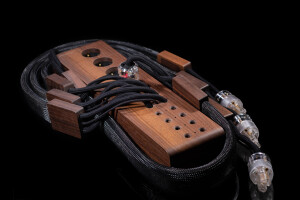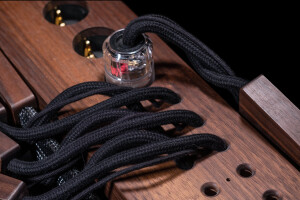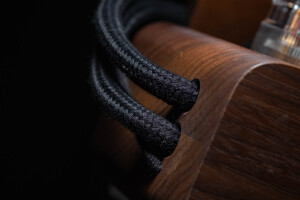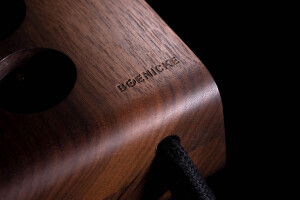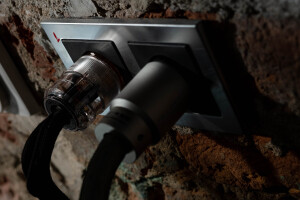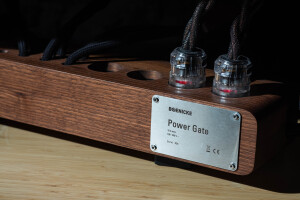After familiarizing myself with Boenicke Audio’s two top shelf cables I was deeply interested in Sven Boenicke’s next developments. As it turns out, I didn’t have to wait long. The Swiss designer next detoured towards power delivery, whereas his own take on the subject – Boenicke Audio Power Gate – is this report’s main dish. Enjoy!
Introduction
Although speakers form the very backbone of Boenicke Audio, just recently its founder/owner Sven Boenicke expanded a fair bit beyond this turf to land several cables based on the C-MARC technology developed by LessLoss. Two of this breed’s upper echelon specimens released under his own banner were already reviewed at this site here and here. Both proved to be profoundly effective and one left the battlefield with our Victor award. As it turns out, that’s not all the poker-faced Swiss had in store for individuals interested in products other than his speakers. In this review we’re about to dig deeper into this uncharted territory and learn what else he did. Suffice to say, the man kept himself very busy in recent months. The view inside Boenicke Audio’s rooms at various shows tells us that several Sven’s not yet released products aren’t truly secretive. Instead of keeping his upcoming work under wraps, the Swiss simply likes to field-test a large chunk of it in challenging event conditions. Boenicke DAC and integrated amp prototypes presented to public eyes in Munich in 2019 were fully operational and looked the part. At this stage many regular audio houses would proceed with official launch follow-ups, but this report’s operation doesn’t quite fit the profile. Although well-known and professional, according to its founder it’ll always be a compact boutique manufacture with a hardcore audio aficionado at its steering wheel. Needless to say, this provides quite a degree of creative flexibility and freedom.
The view inside Boenicke Audio’s rooms at various shows tells us that several Sven’s not yet released products aren’t truly secretive. Instead of keeping his upcoming work under wraps, the Swiss simply likes to field-test a large chunk of it in challenging event conditions. Boenicke DAC and integrated amp prototypes presented to public eyes in Munich in 2019 were fully operational and looked the part. At this stage many regular audio houses would proceed with official launch follow-ups, but this report’s operation doesn’t quite fit the profile. Although well-known and professional, according to its founder it’ll always be a compact boutique manufacture with a hardcore audio aficionado at its steering wheel. Needless to say, this provides quite a degree of creative flexibility and freedom.
Just as he designed a one-off transportable platform for his B:There Records label and related activities, Sven builds pretty much every other component for his private use in the first place. He then takes his time to improve and tinker with it, which explains why some of his stuff already showcased at multiple venues isn’t listed at the Boenicke Audio site. Developments beyond the core Boenicke business simply originate as side projects fueled by Sven’s hobbyist craves and pursue of performance rather than financial gains, and some such prototypes in time grow legs strong enough to stand tall as commercially available goods. This report’s Boenicke Audio Power Gate not only fits this description to perfection, but is Sven’s most unorthodox and radical design to date. Truth told, it’s actually quite crazy.
Build
This report’s Boenicke Audio Power Gate is a fully passive distributor designed to power all connected hardware, that’s its fundamental and only job. A basic strip bought at a local electronic store for pennies does as much, which is why individuals outside the audio hobby would label today’s expense as pure madness. Enthusiasts already aware of the importance of clean power wouldn’t, but Sven’s own awareness on this count is the key part. His latest portfolio addition wasn’t made just to further expand the Boenicke offer and earn a quick buck. This product is quite bonkers even by my standards, but for reasons other than its very steep price. Boenicke Audio Power Gate comprises of a base with four Schuko outlets just as any other such product would, but here’s where similarities of the breed end. This purist power bar was designed as a no-compromise affair with sonic performance set as top priority, and all its internal and external measures contribute to make it so. Today’s solid CNC-milled wooden enclosure is hardly any surprise considering that that’s Sven’s material of choice in all his products. To name just two other audio establishments also fond of it, all LessLoss products feature either ply or Panzerholz exteriors and recently aluminium casings in Aavik’s entire lineup were replaced with wooden boxes. This is not accidental. Many audio manufacturers agree that wood sounds better than aluminium, that’s the short answer. The longer explanation would list the former material’s inherent freedom from electromagnetic reflections and limited acoustic resonances, thus in general nicer working environment for sensitive internal components. Many would also argue that wood visually scores higher than anything else if done right.
Boenicke Audio Power Gate comprises of a base with four Schuko outlets just as any other such product would, but here’s where similarities of the breed end. This purist power bar was designed as a no-compromise affair with sonic performance set as top priority, and all its internal and external measures contribute to make it so. Today’s solid CNC-milled wooden enclosure is hardly any surprise considering that that’s Sven’s material of choice in all his products. To name just two other audio establishments also fond of it, all LessLoss products feature either ply or Panzerholz exteriors and recently aluminium casings in Aavik’s entire lineup were replaced with wooden boxes. This is not accidental. Many audio manufacturers agree that wood sounds better than aluminium, that’s the short answer. The longer explanation would list the former material’s inherent freedom from electromagnetic reflections and limited acoustic resonances, thus in general nicer working environment for sensitive internal components. Many would also argue that wood visually scores higher than anything else if done right.
Each Boenicke Audio Power Gate to an extent can be tailored to a customer’s needs. The core version sold for CHF 7’960 includes the main distributor box plus one permanently attached to its side Boenicke M2 (1.0m) power cord that goes to a wall outlet. As per Sven’s explanation, a screwed down wire’s conductive copper strands oxidize in time to gain semi-conductive properties and become RF receivers, which leads to sound degradation. That’s why he purposely skipped usual IEC inlets and other connections in favor of internally soldered joints and plugs that accept them. A standard Power Gate’s top sports four Furutech’s regular Schuko outs just next to multiple rows of three openings each; two large bores for neutral and live veins and the petite round port in-between for a ground line. These holes can accommodate up to seven extra captive power cables. By ordering my loaner in its basic form I would’ve missed the fun part and going the full hog would’ve been excessive. That’s why Boenicke’s latest power box arrived as a non-standard hydra loaded with three extra M2 output serpents, each finished with its own translucent IEC head and sold for CHF 2’540.
A standard Power Gate’s top sports four Furutech’s regular Schuko outs just next to multiple rows of three openings each; two large bores for neutral and live veins and the petite round port in-between for a ground line. These holes can accommodate up to seven extra captive power cables. By ordering my loaner in its basic form I would’ve missed the fun part and going the full hog would’ve been excessive. That’s why Boenicke’s latest power box arrived as a non-standard hydra loaded with three extra M2 output serpents, each finished with its own translucent IEC head and sold for CHF 2’540.
For years Sven’s been fanatical about resonance control as much as signal conditioning. Measures he’s been using to cover these two bases are inherently universal in application, which is why this story’s Boenicke subject incorporates multiple parts also found in the man’s speakers. Although it’s a fully passive distributor, branding it as a semi-conditioner wouldn’t be wrong considering its internals and action. Bybee’s bullets, LessLoss C-MARC wiring and latest quadruple Firewall 64X modules handle the conditioning task. Wooden exterior plus one series resonator and two parallel units inside it keep resonances at bay. 10%-silver soldered connections up the ante on unobstructed signal flow and provide long-term reliability. Coils, caps and resistors are strictly forbidden. Each Power Gate arrives with a nice brushed stainless steel nameplate on its side and two BR.Big decoupler pads by Black Ravioli. The less susceptible to surroundings and quieter a conductor is, the better it performs regardless of its usage scenario. Sven fully aware of LessLoss C-MARCs’ silent action has been incorporating their various types wherever possible, and a while ago he also financed their special upper echelon breed made for his audio house exclusively. Boenicke M2 cables permanently installed in today’s comprise of coaxial C-MARCs for their neutral and live legs, whereas the smallest C-MARC’s Large Hookup Wire is used for grounding. Each M2’s two wooden blocks with felt inserts in-between keep live, neutral and ground lines nicely separated throughout their entire run; from soldering joints inside the main distributor box all the way up to a translucent plug where they eventually have to meet. This explains why M2 cords are flat, soft and quite flexible in spite of their thick profile.
The less susceptible to surroundings and quieter a conductor is, the better it performs regardless of its usage scenario. Sven fully aware of LessLoss C-MARCs’ silent action has been incorporating their various types wherever possible, and a while ago he also financed their special upper echelon breed made for his audio house exclusively. Boenicke M2 cables permanently installed in today’s comprise of coaxial C-MARCs for their neutral and live legs, whereas the smallest C-MARC’s Large Hookup Wire is used for grounding. Each M2’s two wooden blocks with felt inserts in-between keep live, neutral and ground lines nicely separated throughout their entire run; from soldering joints inside the main distributor box all the way up to a translucent plug where they eventually have to meet. This explains why M2 cords are flat, soft and quite flexible in spite of their thick profile.
Let’s address the pricey elephant in the room. The merciless math informs us that the Swiss newcomer sent my way sells for CHF 15’580 with Swiss VAT and remaining fees included, whereas its maxed out version seven captive M2 power cords would demand cool CHF 25’740. Ouch indeed, however several things need to be taken into account. The basic Power Gate’s coin buys not one product but two conjoined to maximize their sonic potency; the box itself and quality power cord essential anyway. Each additional M2 fixed to the base replaces its regular counterpart. It takes Sven about 15 hours to personally assemble each Power Gate and Switzerland’s wages apply. One meter of LessLoss C-MARC coaxial single-vein cord sells for $156 and my sample required 8 plus extra 4 meters of Large Hookup Wire, $80, each. Three Bybee bullets inside it would set you back for $520, quad-stacked LessLoss Firewall 64X modules add $1’600 extra and today’s wooden enclosure alone eats up $450. Neither Sven’s signature resonators and one high-frequency noise drain module are spare change, nor are Furutech’s outlets and translucent plugs. The man explained that a Boenicke Audio Power Gate with just one input cable demands CHF 4’530 in labor and parts if you were to DIY one for yourself. The takeaway is obvious. This very expensive product isn’t exactly cheap to make either.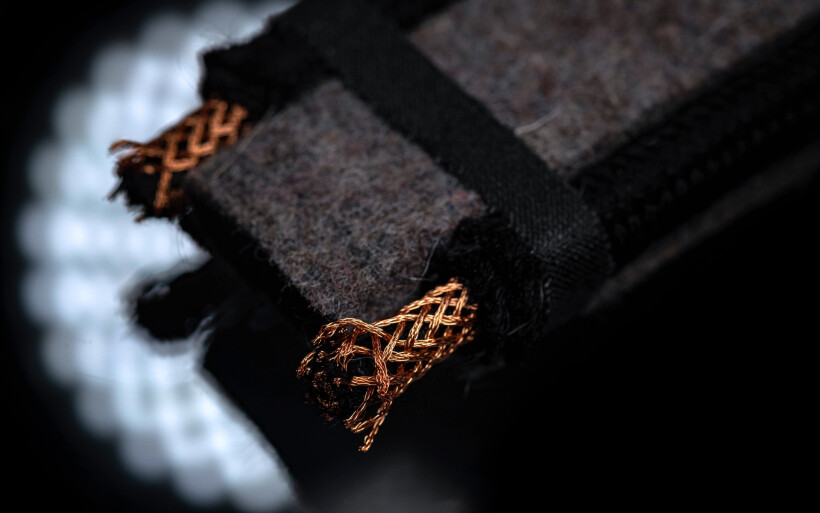 Upon asking the Swiss why his Power Gate came to be, he explained that in existing solutions he simply saw too many design compromises. Sonic performance was the only thing that mattered to him in case of this project, so naturally some functional compromises had to be made. Several months spent with my loaner was time long enough to notice some quirks during daily use. Its flat M2 arms with their C-MARC lines exposed at both ends aren’t exactly easy to align without twisting, and rather large wooden blocks located in these areas didn’t help either. The main distributor box with two small Black Ravioli decouplers underneath is quite stable if positioned and balanced, but even a gentle pull of any fixed M2 snake very easily overturns the base. Wooden openings around installed Schuko outlets are a tight fit for regular plugs, so any non-standard wider connector might not go in.
Upon asking the Swiss why his Power Gate came to be, he explained that in existing solutions he simply saw too many design compromises. Sonic performance was the only thing that mattered to him in case of this project, so naturally some functional compromises had to be made. Several months spent with my loaner was time long enough to notice some quirks during daily use. Its flat M2 arms with their C-MARC lines exposed at both ends aren’t exactly easy to align without twisting, and rather large wooden blocks located in these areas didn’t help either. The main distributor box with two small Black Ravioli decouplers underneath is quite stable if positioned and balanced, but even a gentle pull of any fixed M2 snake very easily overturns the base. Wooden openings around installed Schuko outlets are a tight fit for regular plugs, so any non-standard wider connector might not go in.
It would be best to simply set up a Power Base once and leave it intact for as long as possible, which is what most individuals would do anyway. Due to the nature of my work I couldn’t, multiple hardware swaps per day are nothing out of ordinary. All things considered, my Boenicke sample was manageable but nowhere near as convenient as the full-sized Gigawatt PC-3 SE EVO+ just next to it. At first the former struck me as fragile, but took quite the beating since its arrival and proved me how resilient it truly is. It’s also subject to 20-year full functional warranty. As a hardcore proposition for enthusiasts in pursue of top shelf performance at all cost, today’s also leaves any safety measures typical for its kind at the door. No breakers, protective circuits or fuses. All VDE test runs made it legal to use and sell, however one’s signature under the “At your own risk!” form is a must during the purchase process. Just sayin’
Sound
My fidata HFAS1-S10U handled storage/transport, then LampizatOr Pacific DAC (KR Audio T-100/Living Voice 300B + KR Audio 5U4G Ltd. Ed.) took over to pass the signal to one of the following; Kinki Studio EX-M1, Bakoon AMP-13R, Trilogy 925 or Thöress DFP/AGD Productions Audion combo. From there a Boenicke Audio S3 speaker cable connected either to sound|kaos Vox 3afw or my own Boenicke Audio W11 SE+. All hardware was powered by LessLoss C-MARCs from a GigaWatt PC-3 SE EVO+ power conditioner fronted by its own LC-3 EVO cable. Interconnects used were Boenicke Audio IC3 CG and Audiomica Laboratory Erys Excellence where needed. The USB chain included the full iFi audio stack; a micro iUSB3.0, nano iGalvanic3.0, three Mercury3.0 USB cables in-between plus one 9V iPower. One set of LessLoss Firewall for Loudspeakers modules complimented all loads in this review and Fidelizer EtherStream was in-between my Linksys WRT160N router and fidata server. The plan how to approach this review’s product was formed very quickly. The Power Gate’s three captive cords just next to four regular outlets allowed for several useful triangulations. Its main competitor was of course the GigaWatt, however two regular LessLoss C-MARC power cables on daily duty at my place provided extra insight. At first I had to know how these compared to Sven’s permanently installed M2 counterparts, which was very easy to do. Both C-MARCs at first connected to the Power Gate’s Schuko outlets to feed my DAC and either fidata or an amp of choice from there, and then M2s replaced their Lithuanian kin. Once this base was covered, the Power Gate’s two own cords connected to my DAC and amp of choice, whereas the fidata was powered from this distributor box via Audiomica Laboratory’s Ness Excellence. Then the GigaWatt with two C-MARCs and the same Audiomica’s cable was on duty with previously used components. This allowed me to understand where today’s was versus the PC-3 SE EVO+ alone, namely without all the cable guesswork. If I had three LessLoss specimens this would’ve been even simpler.
The plan how to approach this review’s product was formed very quickly. The Power Gate’s three captive cords just next to four regular outlets allowed for several useful triangulations. Its main competitor was of course the GigaWatt, however two regular LessLoss C-MARC power cables on daily duty at my place provided extra insight. At first I had to know how these compared to Sven’s permanently installed M2 counterparts, which was very easy to do. Both C-MARCs at first connected to the Power Gate’s Schuko outlets to feed my DAC and either fidata or an amp of choice from there, and then M2s replaced their Lithuanian kin. Once this base was covered, the Power Gate’s two own cords connected to my DAC and amp of choice, whereas the fidata was powered from this distributor box via Audiomica Laboratory’s Ness Excellence. Then the GigaWatt with two C-MARCs and the same Audiomica’s cable was on duty with previously used components. This allowed me to understand where today’s was versus the PC-3 SE EVO+ alone, namely without all the cable guesswork. If I had three LessLoss specimens this would’ve been even simpler.
Considering what Sven’s captive M2 cables include, their sonic character similar to my reference C-MARCs based on the same core ingredient was the early assumption. The two compared products were very much alike indeed. Although my ears tracked no differences related to flavouring and the two products clearly were siblings, their input wasn’t identical. Potency is the key word. Sven’s cables did audibly more versus separate LessLoss products. Not by much in the grand scheme of things, but sufficiently enough to view the former lot as more liquid, texturally loaded and with its backdrop a touch darker. In setups chunky and not particularly revealing we’d be splitting hairs most likely. However, both my W11 SE+ floorstanders and sound|kaos Vox 3afw loaners can be safely categorized as resolution monsters keen to flesh out and magnify all changes with ease. It would be thus fair to assume that each M2 cable’s fluffier exterior, separate lines welded to the base and lack of regular plugs did something extra over their regular Lithuanian siblings. Whatever the case was, my most precious takeaway was elsewhere. I could comfortably compare today’s to the GigaWatt and conveniently neglect all used cables’ input (of course minus those that went to the duplex wall outlet), which was one significant variable less to take into account. Now the Swiss wooden box could cleanly go against the local specimen made of steel and aluminium.
In setups chunky and not particularly revealing we’d be splitting hairs most likely. However, both my W11 SE+ floorstanders and sound|kaos Vox 3afw loaners can be safely categorized as resolution monsters keen to flesh out and magnify all changes with ease. It would be thus fair to assume that each M2 cable’s fluffier exterior, separate lines welded to the base and lack of regular plugs did something extra over their regular Lithuanian siblings. Whatever the case was, my most precious takeaway was elsewhere. I could comfortably compare today’s to the GigaWatt and conveniently neglect all used cables’ input (of course minus those that went to the duplex wall outlet), which was one significant variable less to take into account. Now the Swiss wooden box could cleanly go against the local specimen made of steel and aluminium.
Since my GigaWatt’s acquisition some two years ago I’d learnt about its sonic efficiency multiple times. It does everything such a product should do, and to encapsulate its audible input only one word is needed, that would be silence. Benefits associated with it include backdrop cleanliness, instrumental moisture, elevated resolution and far better sensation of the aural space itself. Weightier upstairs and more crack at the other end of the audible range are a part of this posh high-performance package as well. But most importantly, it has no obvious downsides. The PC-3 SE EVO+ in reality is a product that covers all foundational bases and as such is free from sonic trade-offs. It doesn’t alter sound in any way in particular but makes it substantially more easygoing, generous on nuances, sportier, open, smoother and pronounced. With this Polish component music becomes all in all more digestible and flowing. I see no setup that wouldn’t greatly benefit from this very much universal input, of course as long as it doesn’t sport something audibly better already. In this hobby one can’t possibly know what the word ‘better’ actually stands for without experiencing the according change. We happily live in our audio bubbles often convinced that our audio rigs can’t get much better, until they do. Individuals such as myself are exposed to hardware beyond their pay grade, so sampling stuff higher up in the food chain than what’s already owned is just a matter of time, and it so happens that sonics meaningfully improve with a substantial price increase more times than they don’t. That’s exactly what the full Ansuz stack (reviewed here) did very clearly against the GigaWatt. This highly efficient Danish noise-killing hit squad quickly educated me how much more agile, energetic and spatially mighty power components can be. It bested my reference conditioner profoundly enough to effectively push my knowledge about such hardware by several notches, and Boenicke Audio Power Gate did something very similar just now.
In this hobby one can’t possibly know what the word ‘better’ actually stands for without experiencing the according change. We happily live in our audio bubbles often convinced that our audio rigs can’t get much better, until they do. Individuals such as myself are exposed to hardware beyond their pay grade, so sampling stuff higher up in the food chain than what’s already owned is just a matter of time, and it so happens that sonics meaningfully improve with a substantial price increase more times than they don’t. That’s exactly what the full Ansuz stack (reviewed here) did very clearly against the GigaWatt. This highly efficient Danish noise-killing hit squad quickly educated me how much more agile, energetic and spatially mighty power components can be. It bested my reference conditioner profoundly enough to effectively push my knowledge about such hardware by several notches, and Boenicke Audio Power Gate did something very similar just now.
Sven’s power distributor versus the GigaWatt arrived as speedier, spatially more expansive, on textural tissue more organic and tangible yet less warm. On sensual softness it scored as high and injected extra glare, decay and weight into highs. Greater tactility and thunder downstairs suggested stiffer more contoured suspension, additionally boosted by even more generous pigment provision over what the PC-3 SE EVO+ delivered. But upon demand the Swiss box was as relaxed and soothing as its opponent. It also drew virtual sound sources a touch closer to a listener and outlined them finer to present these shapes as a somewhat cooler yet more alive, pronounced and moisturized. All air around them had this particularly pleasant humidity to it the GigaWatt didn’t have as much. Although a touch sunnier in general, the Power Gate also came on top on backdrop spookiness, which very quickly emerged as its refined very distinctive core. Its higher effectiveness on nuance extraction and magnification followed.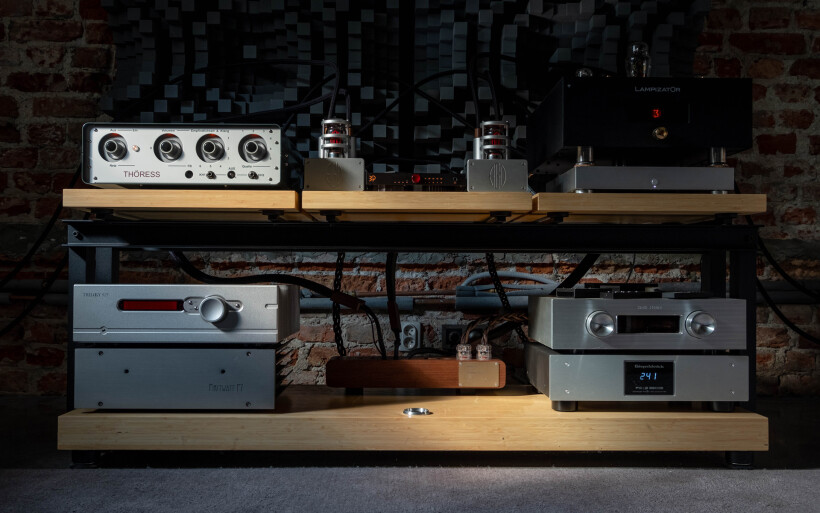 One of the most important changes was in how today’s moved air in my room. Past switching from the GigaWatt sound always became snappier, dynamically more gifted and grander in scale in effect. All instruments and vocals my reference rendered pinpoint accurately, but the Swiss morphed them into bolder, more physical and wilder upon demand, just to become sensual and intimate on a calm minimalist track next on the menu. This versatility in differentiating music types to a deeper degree classified today’s as a product of greater refinement all in all. Each change between the two contestants was easy to single out. The PC-3 SE EVO+ did a lot on its own just as it used to, but its comparison to the Boenicke newcomer left no room for guessing which product of the two was more potent on the silencing job and sonically better. Multiple swaps between both over several months resembled my daily driver’s fight with the Ansuz stack. The magnitude of changes in this report was no lesser and so can’t be its result. The Power Gate emerged as the higher-tiered specimen, which is what its price suggests also.
One of the most important changes was in how today’s moved air in my room. Past switching from the GigaWatt sound always became snappier, dynamically more gifted and grander in scale in effect. All instruments and vocals my reference rendered pinpoint accurately, but the Swiss morphed them into bolder, more physical and wilder upon demand, just to become sensual and intimate on a calm minimalist track next on the menu. This versatility in differentiating music types to a deeper degree classified today’s as a product of greater refinement all in all. Each change between the two contestants was easy to single out. The PC-3 SE EVO+ did a lot on its own just as it used to, but its comparison to the Boenicke newcomer left no room for guessing which product of the two was more potent on the silencing job and sonically better. Multiple swaps between both over several months resembled my daily driver’s fight with the Ansuz stack. The magnitude of changes in this report was no lesser and so can’t be its result. The Power Gate emerged as the higher-tiered specimen, which is what its price suggests also.
Just as it was the case with its fight against the mid-tiered Ansuz set several months ago, my power setup wasn’t beaten to a pulp by the Power Gate as over the years it simply became too good to easily collapse. On foundational silencing work and overall behaviour these products were very similar just as they should be. Nonetheless, it was also clear which one did more in the sense of overall efficacy and pushing my setup’s performance further in effect. The Power Gate shaved off more grit and injected more blackness, but also unlocked access to sound physical, organic, alive and posh versus my GigaWatt’s rounder, warmer, more distant and monolithic execution. That’s why the Power Gate in my private roster positioned itself as the alike-tiered as the Ansuz stack a while ago. If I had to take an educated guess how their comparison would play out, Sven’s product would most likely arrive as beefier and texturally more generous, whereas the other team would score more points on torque and openness.
Summary
The odds are that many enthusiasts even well-accustomed to costly boutique power components will see Boenicke Audio Power Gate as odd, polarizing, too far off from its type and borderline silly. This clearly is no regular distributor box and wasn’t meant to be. Although somewhat challenging, it quickly revealed itself as a no-compromise hardcore affair crafted by a hardcore passionate. If you’re one like-minded individual in pursue of top shelf performance above all else, I’d pay utmost attention to what Sven just did.
Boenicke Audio Power Gate is nicely put together and clearly shows that bling never was a part of this manufacturer’s DNA. Its substantial coin buys one just a wooden box plus several captive power cords after all. As such, this package should be thus seen as a number of products purposely conjoined to work in unison for the greater sonic good, all associated inconveniences and sacrifices be damned. Although today’s allows for rolling regular power cables, finding any similarly priced yet better than its permanently installed Boenicke M2 specimens won’t be easy, this I’m sure of. Lack of any protection measures inside the Power Gate also doesn’t surprise and is typical for its kind.
In my own roster Boenicke’s newcomer positioned itself on the very top just next to the Ansuz A2 loom, and also brilliantly addressed the question about how far this breed’s sonics can be pushed if all else unrelated is cast aside. It takes a particular designer mind to come up with a product as exotic, purist and wicked good as this report’s Power Gate. My tip of the hat to Sven for not taking any prisoners, walking his own walk and in effect landing such a beast. ‘Til next time!
Associated Equipment:
- Amplifier: AGD Productions Audion, Bakoon AMP-13R, Trilogy 925, Kinki Studio EX-M1
- DAC: LampizatOr Pacific (KR Audio T-100 / Living Voice 300B + KR Audio 5U4G Ltd. Ed.)
- Speakers: Boenicke Audio W11 SE+, sound|kaos Vox 3afw
- Transport: fidata HFAS1-S10U
- Preamplifier: Thöress DFP
- Speaker cables: Boenicke Audio S3, LessLoss C-MARC
- Speaker signal conditioning: LessLoss Firewall for Loudspeakers
- Interconnects: Boenicke Audio IC3 CG
- Power components: Gigawatt PC-3 SE EVO+, Gigawatt PF-2 + Gigawatt LC-2 MK2 + Audiomica Laboratory Ness Excellence/LessLoss C-MARC
- USB components: iFi audio iGalvanic3.0, iFi audio micro iUSB3.0, 3x iFi audio Mercury3.0, iPower 9V
- Rack: Franc Audio Accesories Wood Block Rack
- Network: Fidelizer EtherStream, Linksys WRT160N
- Music: NativeDSD, Roon
Retail prices of reviewed components in EU (excl. tax):
- Boenicke Audio Power Gate (as reviewed): CHF 15’580
- Boenicke Audio Power Gate (standard): CHF 7’960
- Boenicke Audio M2 (1.0m) power cable: CHF 2’540
Manufacturer: Boenicke Audio










